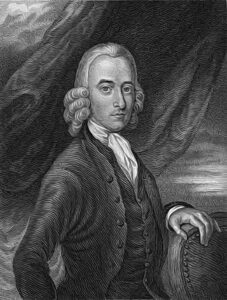
By Michael D. Makidon1
BIOGRAPHY
For most, the Lordship controversy began in the late 1970’s to early 1980’s. However, in an article entitled “History Repeats Itself,” J. I. Packer correctly noted, “The view that saving faith is no more than ‘belief of the truth about Christ’s atoning death’ is not new. It was put forward in the mid-eighteenth century by the Scot Robert Sandeman.”2
If the average Free Grace proponent was told that his view of saving faith was nothing more than a revival of Robert Sandeman’s theology, he would most likely ask, “Who’s Robert Sandeman?”
After discussing the ministry of Sandeman and the ill effects of his view of faith, Packer concludes by stating, “The narrow intellectualism of Sandeman’s view of faith dampened life-changing evangelism. This was one reason why the Glasite-Sandemanian denomination did not survive.”3 Nevertheless, Sandeman’s motto “contending earnestly for the faith which was once delivered unto the saints”4 clearly demonstrates that he was not vying for denominational superiority. Rather, he was merely “contending earnestly for the faith.” Therefore, while Packer’s observation was correct concerning the demise of this group as an organized fellowship, the impact that the theology of Robert Sandeman has had upon the church for the last 250 years cannot be ignored.
While there were certainly many who influenced Sandeman, John Glas, his father-in-law, had one of the greatest effects upon his life.
In 1744, at the age of 26, Sandeman was appointed an elder of Glas’s congregation and became their primary literary publisher. The most controversial and widely read of all his works was Letters on Theron and Aspasio (1757). This work was a dialogue between Sandeman and James Hervey, a well-known Calvinist minister from Northamptonshire, concerning Hervey’s work Dialogues between Theron and Aspasio (1755). In this book, Hervey concentrated on the doctrine of justification by faith. South comments, “Hervey had been influenced by John Wesley at Oxford, but later asserted that he had altered his view of how salvation is obtained, through correspondence with George Whitefield.”5 This dialogue brought Sandeman’s theology into the spotlight.
In Letters on Theron and Aspasio, Sandeman wrote,
But one thing in the general may be freely said, that where the faith necessary to justification is described, every epithet, word, name, or phrase, prefixed or subjoined to Faith, not meant as description of the truth believed, but of some good motion, disposition, or exercise of the human soul about it, is intended, and really serves, instead of clearing our way, to blindfold and decoy us; to impose upon us, and make us take brass for gold, and chaff for wheat; to lead us to establish our own, in opposition to the divine righteousness; even while our mouths and our ears are filled with high sounding words about the latter.6
Two hundred years later, Earl Radmacher echoed Sandeman’s sentiment with these words: “We need to beware of the tendency to over-psychologize the word ‘faith’ and add to it more semantic baggage than it was ever intended to carry by distinguishing faith and saving faith or some other kind of faith.”7
Apparently, just as the word “faith” has been over-psychologized in the twenty-first century, so it was in Sandeman’s day.
Sandeman said that “justification comes from bare faith.”8
In 1760, word reached Sandeman in London that his work Letters on Theron and Aspasio had caused quite a stir in the American colonies. Encouraged by their response to his views on bare faith, Sandeman, with John Glas’s blessing, left England for America.
Sandeman became an elder of a congregation in Danbury, Connecticut, where he died on April 2, 1771.
SANDEMANIANISM
Theopedia has this brief explanation of what has come to be called Sandemanianism:
Sandemanianism refers primarily to an aspect of theology regarding the nature of faith promoted by Robert Sandeman (1718-1781 [sic]), from which it derives its name, and his father-in-law John Glas (1695-1773) in Scotland and England during the mid-18th century.
To the Sandemanians, the nature of saving faith reduces to mere intellectual assent to a fact or proposition. This is illustrated rather clearly in the following quote. “In a series of letters to James Hervey, the author of Theron and Aspasia [sic], he [Sandeman] maintained that justifying faith is a simple assent to the divine testimony concerning Jesus Christ, differing in no way in its character from belief in any ordinary testimony.”9
Those who hold to the concept of Lordship salvation argue that the view espoused by proponents of Non-Lordship salvation is essentially the errant view of the 18th century Sandemanians.10
____________________
Michael has a Th.M. from DTS and a Ph.D. from South African Theo. Seminary, serves as an elder at Centerpoint Church (Mesquite, TX), and resides in Rockwall, TX with his wife, Gina, and two kids, Josiah and Emma.
1 Editor: A much longer form of this article appeared in JOTGES (Spring 2002): 75-92. Available at www.faithalone.org. The quotation of the article on Sandemanianism from Theopedia was added by the editor.
2 J. I. Packer, “History Repeats Itself,” Christianity Today (September 1989): 22.
3 Ibid.
4 Thomas J. South, “The Response of Andrew Fuller to the Sandemanian View of Saving Faith,” (Th. D. dissertation, Mid-America Baptist Theological Seminary, 1993), 60.
5 Ibid., 59.
6 Robert Sandeman, Letters on Theron and Aspasio, vol. 2 (Edinburgh: Sands, Donaldson, Murray, and Conchran, 1759), 329-30.
7 Earl Radmacher, “First Response to John F. MacArthur, Jr.,” JETS (March 1990): 38.
8 Sandeman, Letters, 329-330.
9 Encyclopedia Britannica, Eleventh Edition (1911), now in the public domain; s.v. Glasites, or Sandemanians, bracket (i.e., [Sandeman])added.
10 “Sandemanianism,” available at https://www.theopedia.com/sandemanianism. Last accessed April 14, 2022.
